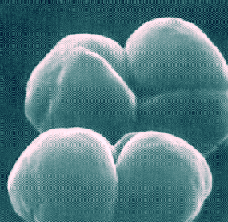Please note: Osher Rainforest will be closed for maintenance Jan. 14–16.
Science News
Small Culprits in Largest Extinction
April 3, 2014
by Molly Michelson
0

Little things can go a long way. We demonstrated that yesterday describing how zebras have evolved stripes to protect them from small biting flies, not large carnivorous predators. That’s nothing compared to today’s story about little things: new research suggests that small microbes, not large asteroids or volcanoes, were responsible for the largest mass extinction on our planet.
The end-Permian mass extinction, or “Great Dying,” occurred 252 million years ago, wiping out as many as 70% of terrestrial vertebrates and perhaps 90% of all marine species. As significant as the event was, pinpointing the actual culprit has been difficult and controversial.
Researchers at the Massachusetts Institute of Technology (MIT) investigated the cause by first looking at the exponential increase of carbon dioxide experienced by the oceans at that point in geologic time. Previously, researchers suggested that the increase in CO2 originated from the volcanic eruptions that produced the Siberian Traps, a vast formation of volcanic rock shaped by the most extensive eruptions in Earth’s geological record. But calculations by the MIT team show that these eruptions were not nearly sufficient to account for the carbon seen in sediments dating back to that epoch. In addition, the observed changes in the amount of carbon over time don’t fit the volcanic model.
“A rapid initial injection of CO2 from a volcano would be followed by a gradual decrease,” says MIT postdoc Gregory Fournier. “Instead, we see the opposite: a rapid, continuing increase. That suggests a microbial expansion.” The growth of microbial populations is among the few phenomena capable of increasing carbon production exponentially.
The team then focused their attention on the methane-producing archaea called Methanosarcina. Using genetic analysis, the scientists determined a gene transfer from another microbe occurred right around the time of the end-Permian extinction. (Previous studies had only placed this event sometime in the last 400 million years, but the researchers refined that estimate to a date near the end of the Permian.) Given the right conditions, this genetic acquisition set the stage for the microbe to undergo a dramatic growth spurt, rapidly consuming a vast reserve of organic carbon in the ocean sediments.
The researchers propose that as Methanosarcina suddenly bloomed explosively in the oceans, they released prodigious amounts of methane into the atmosphere and dramatically changing the climate and the chemistry of the oceans. And the planet forever, as Christopher Joyce reports on NPR, “the extinction kind of rebooted life on Earth.”
The Academy’s Curator of Geology, Peter Roopnarine, chimed in via email: “The paper represents a significant step forward in our understanding the dramatic changes which took place in the carbon cycle at the very end of the Permian… and how those changes unfolded.” But he remains skeptical: among other things, evidence suggests that the extinction event occurred in multiple phases, inconsistent with the MIT team’s hypothesis, and although the researchers narrowed down the timing of the aforementioned gene transfer, they can only say it occurred within tens of millions of years of the end-Permian extinction. “The paper presents a very insightful and sophisticated analysis of the carbon problem at the end of the Permian, but I find the link between that and the methanogenic microbes to be speculative and unnecessary.”
And so the controversy continues!
The research is published this week in Proceedings of the National Academy of Sciences.
0